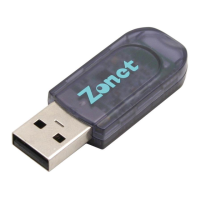Bluetooth USB Adapter User’s Manual
34
6.6.1 Notifications
Overview
There are three types of notification:
• Authentication request, also called a PIN code request—this notification is
displayed automatically in a balloon over the Windows system tray if a Personal
Identification Code is required before a connection can proceed. An audio file can
also be associated with the notification.
• Authorization request, also called a connection request—this type of notification
can be visual, audio, or both. It notifies you of attempts to access a Bluetooth
service on this computer; the connection will not proceed until you click the
balloon that is displayed over the Windows system tray. If the notification balloon
is ignored, the connection request will time out and fail.
•
Notification only—this type of notification does not affect access in any way; it is
solely for information purposes to let you know that a connection has been
established.
Example
Both Authentication and Authorization request notifications are controlled by whether
Secure Connection is enabled for an individual service.
An example of how notifications might work when a remote device attempts to access a
service on this computer, if all notifications are enabled:
1. Authentication: a balloon notification (audio optional) prompts you for a PIN code.
If the PIN code does not match the code entered on the remote device, the
connection will not be allowed. Once the remote device has been authenticated this
notification will not appear again, unless the paired relationship is broken. If the
paired relationship is broken, the devices must re-pair.
2. Authorization: a balloon notification is displayed and/or a sound file provides
audio notification that a remote device is attempting to access a Bluetooth service
on this computer. Click the balloon to proceed. A dialog box prompts you to
enable the connection only once, or to allow this device to use the service every
time.
3. Once a connection has been authorized, an additional visual and/or audio
notification may be displayed (if enabled). This notification is for information only
to inform the operator that a connection has been established.
After two devices are paired (step 1, above), the authentication notification will no longer
be displayed when a connection is attempted.
If “Always allow…” is enabled during the authorization process (step 2, above), the
authorization notification will not be displayed on future connection attempts.
Connection notification (step 3, above) only happens if it has been enabled on the
Notifications tab of the individual service being accessed.

